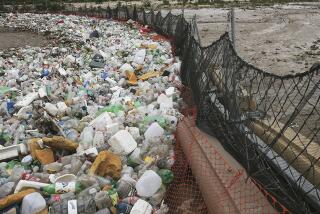Airport Site Set in Mexico
- Share via
MEXICO CITY — Ending a vexing debate that lasted a third of a century, the Mexican government announced Monday that it will relocate Latin America’s largest airport to a mostly dry lake bed east of the capital.
The decision to build a desperately needed new airport in the Lake Texcoco area angered environmentalists, who argue that a nature preserve near the proposed site provides a vital winter home for tens of thousands of migratory birds.
Communications and Transport Minister Pedro Cerisola said the project will include efforts to protect the environment. Lakes and parkland will be created near the airport, he said.
The government chose the Texcoco site, about 20 miles east of downtown Mexico City, over a site in Tizayuca, about 45 miles north in Hidalgo state. The Tizayuca site would have been among the farthest airports from a downtown in the world.
Building the airport just southwest of Texcoco will mean closing the existing Benito Juarez International Airport, about 10 miles away, and consolidating all flights at the new facility. The Hidalgo option would have served only international flights, with the existing airport staying open for domestic traffic, raising thorny problems of providing inter-airport transfers for passengers with connecting flights.
At least the government of President Vicente Fox finally made a decision. Cerisola noted that in 1968, when the city airport already was overcrowded and inadequate, President Gustavo Diaz Ordaz deferred the decision. That practice was followed by successive presidents, including Fox’s predecessor, Ernesto Zedillo.
One of Diaz Ordaz’s options was to expand the existing airport, at a time when there was still enough land nearby to do so. In the intervening years, the population of Mexico City and the surrounding valley boomed to nearly 20 million, making such expansion impractical.
So Benito Juarez International hobbled along as traffic grew from 2.9 million passengers annually to 21 million last year and the number of flights surged from 57,000 to 280,000. The growth projection for the airport, already the busiest in Latin America, was for traffic to more than double by 2015.
At a cost of $2.3 billion, the Texcoco option is about 30% cheaper than Tizayuca would have been. Texcoco will have six runways, though only three will be operational at any time.
Cerisola said the Fox government commissioned several studies to supplement the numerous investigations conducted in the past. The research covered soil problems in the boggy lake bed, noise pollution, concerns about airplanes hitting birds, traffic issues and the cost of having two airports versus an integrated operation.
The studies showed that “both sites were viable; neither of the two presented unsolvable problems,” Cerisola said. But the Texcoco option was preferable from both a flight operations and an economic perspective, he said.
Still, environmentalists pledged to challenge the decision. Homero Aridjis, a writer who heads the Group of 100 environmental action group, said the project jeopardizes 30 years of work to recover the ancient lake network in Texcoco, part of Mexico City’s Aztec-era water system.
The Group of 100 and other activists will challenge the project through the North American Commission for Environmental Cooperation, Aridjis said. The commission was created under the North American Free Trade Agreement.
*
Rafael Aguirre of The Times’ Mexico City Bureau contributed to this report.
More to Read
Sign up for Essential California
The most important California stories and recommendations in your inbox every morning.
You may occasionally receive promotional content from the Los Angeles Times.













